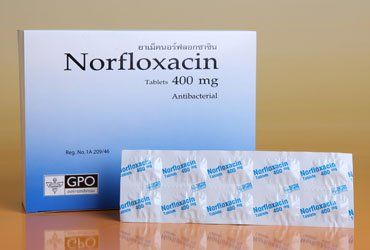This is an automatically translated article.
Norfloxacin works to kill bacteria by inhibiting enzymes necessary for bacterial DNA regeneration. The drug is prepared in the form of 200mg, 400mg film-coated tablets or 0.3% ophthalmic solution.
1. What is Norfloxacin?
Norfloxacin is an antibiotic of the quinolone group (fluoroquinolone subgroup), similar to ciprofloxacin.Norfloxacin is indicated in the following cases:
Used in adults to treat urinary tract infections (with or without complications) and prostatitis caused by susceptible bacteria; Norfloxacin ophthalmic solution is used to treat blepharitis, blepharitis, and conjunctivitis caused by susceptible strains of bacteria. Norfloxacin is contraindicated in the following cases:
People with hypersensitivity to Norfloxacin, quinolones or components contained in the preparation; Patients with a history of tendonitis, tendon rupture related to the use of quinolones; Children under 18 years of age (end of development).

Norfloxacin được sử dụng để điều trị các bệnh nhiễm trùng do vi khuẩn.
2. How to use and dosage of Norfloxacin
How to use: With the drug Norfloxacin 400mg tablet, use orally. With Norfloxacin eye drops, eye drops are used. When taking the drug, it is recommended to take Norfloxacin at least 1 hour before a meal or 2 hours after eating/drinking milk, with a full glass of water. During the day, patients need to drink a lot of water so that the urine output is at least 1200-1500ml/day for adults.
Dosage: Due to the risk of crystalluria - should not be used more than 400mg/time, twice a day in healthy adults with normal renal function. Specific dosage for people 18 years of age and older is as follows:
Acute prostatitis and acute cystitis: 400mg/time, 2 times/day, for about 7-10 days (3 days for urinary tract infections). uncomplicated urinary tract infection in women) or use this dose to treat uncomplicated urinary tract infections caused by E.coli, Proteus mirabilis or Klebsiella pneumoniae; Chronic recurrent lower urinary tract infections: 400mg/time, 2 times/day for 12 weeks. Dosage can be reduced to 400mg/time/day if there is a good response in the first 4 weeks of treatment; Chronic prostatitis: 400mg/time, 2 times/day for 28 days; Eye infections: Instillation of Norfloxacin 0.3% ophthalmic solution. Dosage for patients with renal failure (ClCr ≤ 30ml/min/1.73 m2): 400mg/time/day for patients with urinary tract infections.
Dosage for patients with hepatic impairment : No need to change or adjust the dose.
Overdose: Symptoms of overdose include diarrhea, nausea, dizziness, headache, pseudomembranous colitis, pain and tendinitis. Because there is no specific antidote when using Norfloxacin overdose, the treatment is usually symptomatic treatment such as inducing vomiting, gastric lavage, performing water and electrolyte replacement,...
Missed dose: If If you forget to take a dose of Norfloxacin, you should take it as soon as you remember. If it is almost time for your next dose, skip the missed dose and take your next dose at the same time as originally planned.
3. Side effects when using Norfloxacin
Some side effects patients may have when taking Norfloxacin 400mg:
Common: Nausea, diarrhea, headache, abdominal cramps, dizziness, eosinophilia, increased liver enzymes; Uncommon: Fever, rash, itching, drowsiness, photosensitivity, vomiting, diarrhea, abdominal pain, loss of appetite, constipation,...; Rare: Anorexia, depression, poor sleep, anxiety, psychomotor agitation, euphoria, hallucinations, disorientation, stomatitis, arthralgia, pseudomembranous colitis,...

Khi dùng thuốc norfloxacin nếu thấy xuất hiện các hiện tượng như buồn nôn, tiêu chảy, đau thì đây là những tác dụng phụ của thuốc bạn cần lưu ý
4. Be careful when using Norfloxacin
Some notes users need to remember before using Norfloxacin:Risk of tendonitis and tendon rupture may occur when using quinolone antibiotics. This risk is increased with concomitant use of corticosteroids, patients over 60 years of age, and organ transplant patients. Therefore, treatment with norfloxacin should be discontinued if the patient develops painful tendonitis. Thereafter, the use of fluoroquinolones must be contraindicated in these patients; Norfloxacin should be used with caution in elderly patients with impaired renal function. The dose should be 1/2 of that of a normal person; Norfloxacin should be used with caution in patients with epilepsy or a history of central nervous system disorders; Norfloxacin should be used with caution in patients with liver or kidney failure if ClCr < 10ml/min, need to reduce drug dosage and monitor ClCr index; Do not give fluoroquinolones to children and adolescents; Fluoroquinolones and other quinolones may cause arthropathy in animals. Therefore, it should be used with caution when administering Norfloxacin to people with arthritis because of the increased risk of tendon rupture; Avoid concomitant use of Norfloxacin with antiarrhythmic drugs,...; The drug can cause photosensitivity reactions, so patients should avoid sun exposure; Norfloxacin should not be used by pregnant or lactating women. In case it is necessary to take Norfloxacin, breast-feeding should be discontinued during its use; Norfloxacin can cause side effects such as headache, dizziness, so it should be used with caution for people who drive, operate machinery, ...
5. Norfloxacin drug interactions
Some drug interactions of Norfloxacin include:
Some studies have shown the results: The antacids containing aluminum, magnesium hydroxide reduce the absorption from 50 to 98% of Norfloxacin in serum; Using Maalox 2 hours after taking Norfloxacin will reduce the amount of Norfloxacin absorbed by the body by up to 1/3; Using calcium carbonate with Norfloxacin reduces absorption by 50 - 60%; Norfloxacin is not affected by bismuth subsalicylate; Co-administration of Norfloxacin with probenecid did not affect serum concentrations of Norfloxacin but reduced urinary excretion of the drug; Administration of Norfloxacin together with theophylline and cyclosporin increases serum concentrations of these two substances; Norfloxacin (like other quinolones) enhances the effect of anticoagulants (such as warfarin or its derivatives). Therefore, when using these drugs, it is necessary to monitor the clotting time by performing appropriate testing; Do not use preparations containing trace elements containing zinc and iron together with Norfloxacin or within 2 hours of Norfloxacin as it may decrease the concentration of Norfloxacin in serum and urine; Norfloxacin (like other quinolones) may affect the metabolism of caffeine, reduce caffeine clearance, prolong the plasma half-life of caffeine; Norfloxacin may reduce the effect of mycophenolate, BCG, sulfonylurea, typhoid vaccine; Avoid concomitant use of Norfloxacin with drugs: BCG, Artemether, nilotinib, nitrofurantoin, quinine, dronedarone, pimozide, lumefantrin, tetrabenazine, vandetanib, vemurafenib, thioridazine, tolvaptan, toremifen, ziprasidone,...

Không nên dùng Norfloxacin chung với các chế phẩm từ sữa
In addition, mean peak serum concentrations of norfloxacin may be reduced if taken with food or dairy products. Norfloxacin is an antibiotic, used to treat many infectious diseases caused by bacteria. When taking drugs, to avoid the risk of drug interactions causing adverse reactions, users need to inform their doctors about the drugs they are taking.
Please dial HOTLINE for more information or register for an appointment HERE. Download MyVinmec app to make appointments faster and to manage your bookings easily.













